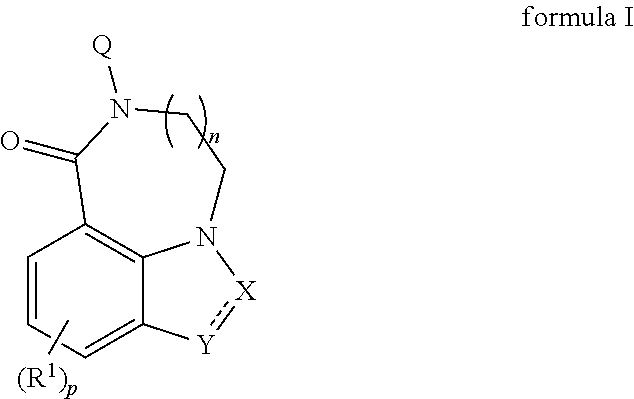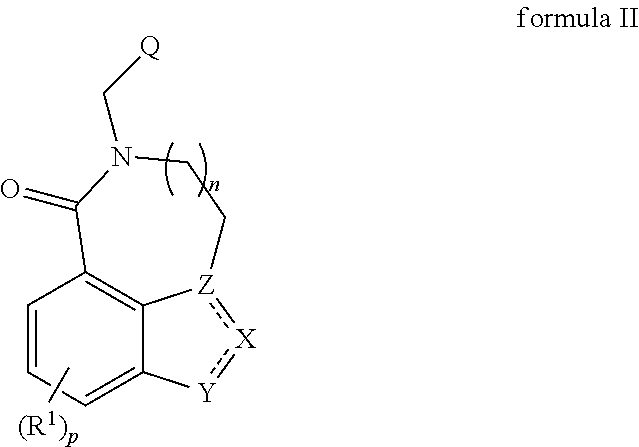5-ht3 receptor modulators, methods of making, and use thereof
a technology of receptor modulator and serotonin type 3, which is applied in the direction of biocide, drug composition, metabolic disorder, etc., can solve the problems of patients refusing to take further chemotherapy, withdrawn alosetron from the market, unfavorable consequences, etc., and achieves high affinity
- Summary
- Abstract
- Description
- Claims
- Application Information
AI Technical Summary
Benefits of technology
Problems solved by technology
Method used
Image
Examples
example 1
Preparation of (R)-2-(quinuclidin-3-yl)-3,4-dihydro-[1,4]diazepino[6,7,1-hi]indol-1(2H)-one, hydrochloride salt
[0132]
[0133]Step A: To a stirred solution of methyl 1H-indole-7-carboxylate (2.0 g, 11.4 mmol) in DMF (10 ml) was added sodium hydride (800 mg, 20 mmol) in portions. The mixture was stirred at room temperature for 1 h, then potassium iodide (160 mg, 0.9 mmol) and 2-bromo-1,1-dimethoxyethane (3.4 ml, 28.5 mmol) were added. The mixture was heated to 80° C. for 15 h. After cooling to room temperature, the reaction was quenched with saturated aqueous ammonium chloride, extracted with ethyl acetate (3×), washed with brine, dried over sodium sulfate, filtered, and concentrated under reduced pressure. The crude material was purified by column chromatography (silica gel, 70:30 hexanes / ethyl acetate) to afford methyl 1-(2,2-dimethoxyethyl)-1H-indole-7-carboxylate (1.77 g, 59%) as a semitransparent liquid: 1H NMR (500 MHz, CDCl3) δ 7.77 (dd, J=4.5, 1.0 Hz, 1H), 7.66 (dd, J=4.3, 1.0 H...
example 2
Preparation of (S)-2-(quinuclidin-3-yl)-3,4-dihydro-[1,4]diazepino[6,7,1-hi]indol-1(2H)-one, hydrochloride salt
[0138]
[0139]Step A: To methyl 1H-indole-7-carboxylate (2.0 g, 11.4 mmol) dissolved in DMF (10 ml) was added sodium hydride (800 mg, 20 mmol) in portions. The mixture was stirred at room temperature for 1 h, then potassium iodide (160 mg, 0.9 mmol) and 2-bromo-1,1-dimethoxyethane (3.4 ml, 28.5 mmol) were added. The mixture was heated to 80° C. and stirred overnight. After cooling to room temperature, the mixture was quenched by saturated aqueous ammonium chloride, extracted with ethyl acetate (3×), washed with brine, dried over sodium sulfate, filtered, and concentrated under reduced pressure. The crude material was purified by column chromatography (silica gel, 70:30 hexanes / ethyl acetate) to afford methyl 1-(2,2-dimethoxyethyl)-1H-indole-7-carboxylate (1.77 g, 59%) as a semitransparent liquid: 1H NMR (500 MHz, CDCl3) δ 7.77 (dd, J=4.5, 1.0 Hz, 1H), 7.66 (dd, J=4.3, 1.0 Hz,...
example 3
Preparation of (S)-7-methyl-2-(quinuclidin-3-yl)-3,4-dihydro-[1,4]diazepino[6,7,1-hi]indol-1(2H)-one, hydrochloride salt
[0144]
[0145]Step A: Phosphorus(V) oxychloride (0.7 ml, 7.6 mmol) was slowly added to DMF (5 ml) at 0° C. The mixture was stirred for 15 min and then was treated with a solution of (S)-2-(quinuclidin-3-yl)-3,4-dihydro-[1,4]diazepino[6,7,1-hi]indol-1(2H)-one (250 mg, 0.8 mmol) from Step E of Example 2 in DMF (5 ml). The reaction mixture was warmed to room temperature and stirred overnight. After removing the solvent under reduced pressure, the residue was dissolved in water and basified using saturated sodium carbonate to precipitate (S)-1-oxo-2-(quinuclidin-3-yl)-1,2,3,4-tetrahydro-[1,4]diazepino[6,7,1-hi]indole-7-carbaldehyde (148 mg, 63%) as a white solid: 1H NMR (500 MHz, CD3OD) δ 9.94 (s, 1H), 8.43 (d, J=4.0 Hz, 1H), 8.14 (s, 1H), 8.07 (d, J=3.8 Hz, 1H), 7.41 (t, J=7.5 Hz, 1H), 4.71 (br s, 1H), 4.53 (s, 1H), 4.46 (d, J=5.5 Hz, 1H), 4.08 (br s, 1H), 3.98 (dd, J=1...
PUM
| Property | Measurement | Unit |
|---|---|---|
| Molar density | aaaaa | aaaaa |
| Molar density | aaaaa | aaaaa |
| Molar density | aaaaa | aaaaa |
Abstract
Description
Claims
Application Information
 Login to View More
Login to View More - R&D
- Intellectual Property
- Life Sciences
- Materials
- Tech Scout
- Unparalleled Data Quality
- Higher Quality Content
- 60% Fewer Hallucinations
Browse by: Latest US Patents, China's latest patents, Technical Efficacy Thesaurus, Application Domain, Technology Topic, Popular Technical Reports.
© 2025 PatSnap. All rights reserved.Legal|Privacy policy|Modern Slavery Act Transparency Statement|Sitemap|About US| Contact US: help@patsnap.com



